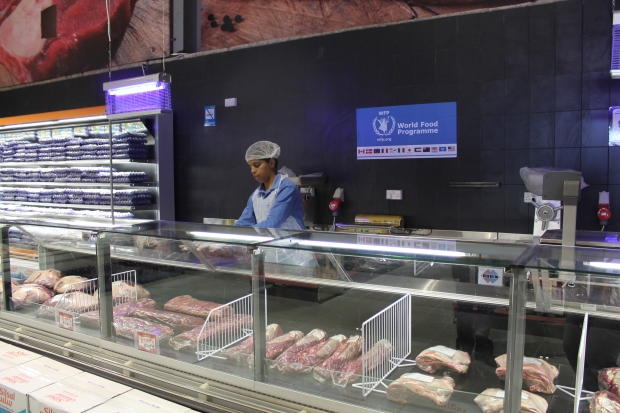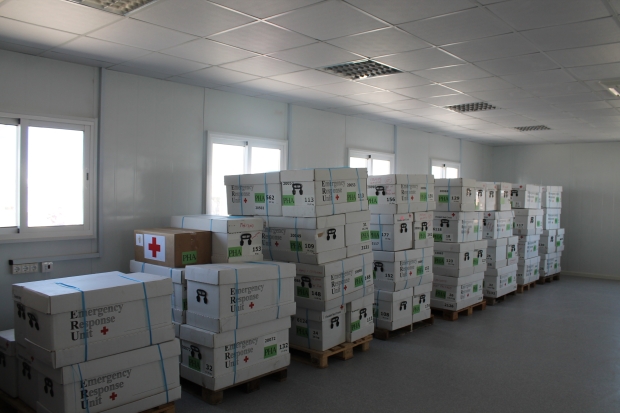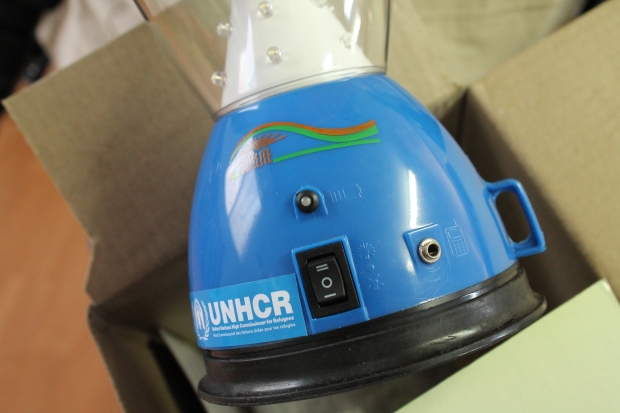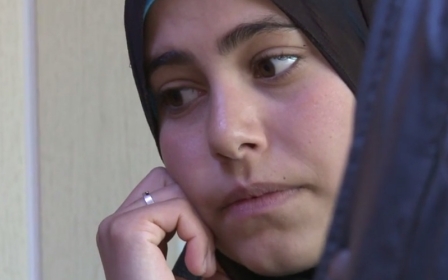Jordan tries new tack with Azraq refugee camp
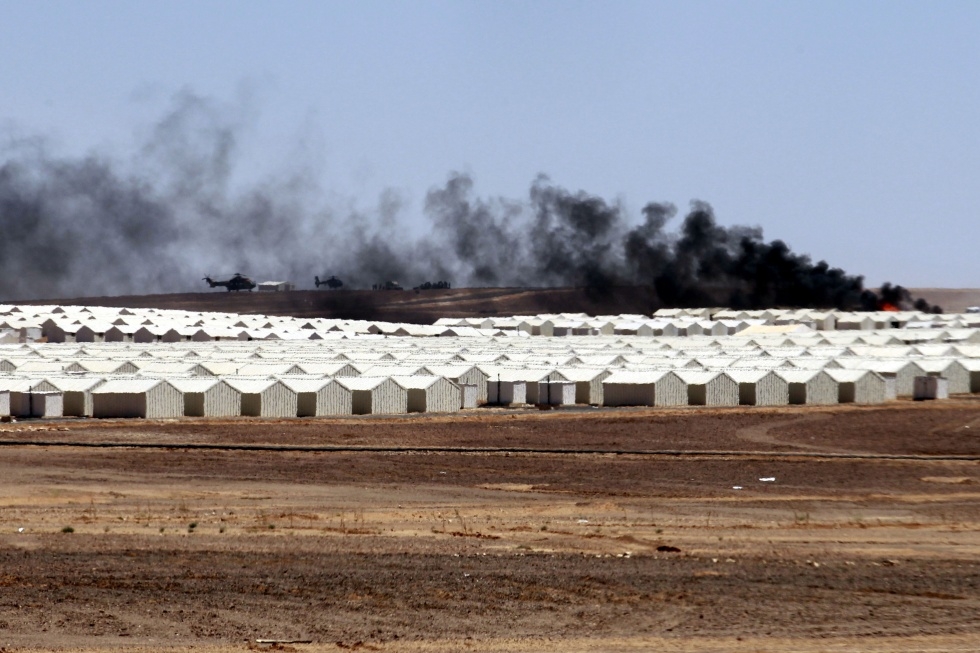
History was made this week in the flat, yellowish, rocky desert about 60 miles (100km) east of Amman. The air shimmered and temperatures topped 30 degrees Celsius as diplomats, politicians, high-ranking members of the Jordanian military and aid workers came together to open something they admit they’re looking forward to closing: Azraq refugee camp.
Azraq is Jordan’s fifth camp for Syrian refugees and its second purpose-built one. At its full capacity of 130,000 people, it will be the country’s largest. Za’atari, which operates best at around 80,000 people, will be a distant second place.
Although just 437 Syrians called Azraq home on opening day, the camp currently has shelters for 25,000 and infrastructure for 50,000. It’s ready to grow - fast.
This preparedness and flexibility are part of what makes Azraq stand out: in the hyper-reactive world of disaster management, the camp has benefited from an almost unheard of amount of planning, funding and expertise.
“What you see here is one of the best-planned refugee camps in the world,” said Andrew Harper, the UN refugee agency’s representative to Jordan.
New MEE newsletter: Jerusalem Dispatch
Sign up to get the latest insights and analysis on Israel-Palestine, alongside Turkey Unpacked and other MEE newsletters
It’s also well more than a year in the making, and a testament to the Hashemite Kingdom’s willingness to help those people its Minister of the Interior, General Hussein Al-Majali, called “our Syrian brothers”.
While much of the cost of sheltering refugees is borne by the UN and humanitarian organisations, and through donations by other governments. Jordan - a water-scarce, upper middle income country wrestling with a double-digit unemployment rate - has hardly had an easy ride in this respect.
Security challenges
Over the past three years, the Kingdom has seen its population rise by 10% and its infrastructure strain under the weight of hosting so many people. Despite all the attention Jordan’s camps receive, the vast majority of refugees don’t actually live in camps, but in cities like Amman, Irbid, Zarqa and Ramtha, where aid logistics are more complex and rents and tensions are rising.
The security challenges that were once routine at Za’atari but had almost been forgotten returned this past week when a riot left one man dead and several injured. You’d be forgiven for thinking the Jordanian authorities might balk at creating another temporary city for the displaced.
“We’ve learned a lot from our mistakes, and there were many mistakes,” admitted Al-Majali at Azraq’s opening.
Even in these early days, it’s clear that much of the effort invested in Azraq has been focused on learning from Za’atari’s failures and successes.
Unlike Za’atari’s early days, where aid workers would pitch tents at night by the glow of a mobile phone as refugees streamed through the camp gates, Azraq is ready to house any human deluge in already-standing structures called Transitional Shelters, or T-shelters.
Made of a steel frame and zinc-treated iron cladding, T-shelters measure six by three meters and include space for families to safely cook their own meals. (Unlike tents, which are highly flammable, and unlike caravans, which require ventilation to be added before residents can safely operate a gas stove.)
'More saving every day'
T-shelters are insulated, so they’re cooler in summer and warmer in winter, and they offer residents a degree of privacy tents and pre-fabricated caravans lack. Privacy might not seem an obvious concern in an emergency response, but it’s part of ensuring residents are able to maintain a sense of dignity.
That focus on dignity and providing some sort of normalcy in the most abnormal of situations extends to the provision of food aid. Azraq is the first refugee camp in the world to open with a fully stocked supermarket: wide aisles, fluorescent lighting, a deli counter, myriad varieties of tea and even teriyaki sauce.
The Sameh Mall supermarket - slogan: More Saving Every Day - is open for business. It accepts cash and World Food Programme vouchers, which are distributed to residents monthly in accordance with family size. On opening day it was staffed by young men from the nearby town of Azraq, 20km away, but as the camp grows, residents will also stock shelves, ring up orders and bag groceries.
This is a concept that rolled out at Za’atari in early 2014 and proved enormously, unsurprisingly popular: Syrian families are accustomed to shopping at markets and choosing their own food. Enforcing a rigid rations system at Za’atari only frustrated people and opened the door for the resale of relief goods.
Another point of comparison between Za’atari and Azraq is layout. Za’atari was initially set out in sectors, with tents and caravans arranged grid style, and communal toilets, showers and kitchens scattered throughout. This didn’t work. In many cases, as soon as tents had been pitched and caravans placed, families were on the move, picking up their homes and moving them to be closer to kin. Often, relatives would create smaller family neighbourhoods where dwellings faced each other.
The communal hygiene facilities also missed the mark: families weren’t comfortable showering in shared facilities so far from their homes. Za’atari camp boss Kilian Kleinschmidt wryly referred to the practice of “privatisation”, where residents would “liberate” communal items, often from wash facilities, for private use. Before its first birthday, 8 percent of Za’atari residents had their own water tanks.
Azraq employs lessons learnt here, and is from the very start set out in family village-style neighbourhoods, six T-shelters to two toilets (one male, one female) and one shower. The hope is that people won’t have to share their personal space with strangers.
Medical facilities are another area where Za’atari’s findings have been put to use. Azraq’s field hospital is a network of bright, spacious caravans on concrete foundations. There’s an ambulance bay and several operating rooms, and powerful air conditioning keeps the place cool and hushed.
“It’s a pre-fab building compared to a MASH-style tent,” said Nina Benecke from the middle of a stock room filled with boxes of nappies and medical equipment.
In her role as medical coordinator with the Finnish Red Cross, Benecke has overseen the development of Azraq’s health care offering. “This population has a lot of women of child-bearing age, and we can deal with caesarean sections and complicated deliveries here.”
This contrasts sharply to Za’atari, where complicated deliveries - with between eight and 10 children born each week, a fairly consistent fact of life - are shuttled by ambulance to Mafraq Hospital.
But beyond these clear improvements on the Za’atari model, Azraq also raises some questions about the longer-term sustainability of such an enormous camp in this location.
Water is one critical issue. Azraq currently relies on water trucks, which is, as one seasoned aid worker said, “Bad news: it’s expensive, bad for the environment and donors hate it.”
But 35 litres of water per person per day will be trucked to Azraq each day and poured into seven 95,000 litre tanks, then piped to 39 water stands throughout the camp.
“It’s potable but not really tasty,” said Bob Neufeld of World Vision, one of the NGOs responsible for water at the camp. “We’re suggesting residents boil water before drinking it, but we’re constantly testing it, 24/7, to make absolutely certain.”
A better solution, Neufeld explains, would be to drill wells or boreholes, but
results so far have been salty - and desalination would be yet another step and another cost. What’s more, the region of Azraq hosts a shrinking wetland. Drilling locally for water could damage this already fragile environment.
Integration challenge
Another crucial way Azraq differs from Za’atari is its approach to electricity. Za’atari ran electricity through the camp in order to power infrastructure, but entrepreneurial residents quickly created an informal electricity economy, which cost UNHCR up to $500,000 USD per month in electricity bills, but facilitated the development of a Za’atari economy. People created livelihoods and began to rebuild their lives. This, Kleinshmidt said, is one of the things that allowed Za’atari to evolve from emergency mode to development mode. And the long-term goals of humanitarian work include helping refugees become self-reliant, move off aid, and integrate into the host community. This happened at Za’atari thanks to business connections between the Syrians who live at the camp and Jordanians from nearby cities.
But at Azraq, where the only readily available power comes from an outlet on one of the two solar-powered lamps given to families when they arrive, the potential for industry - the falafel stands, chicken shops, computer game arcades, clothing stores and mobile phone charging stalls that made Za’atari come alive - looks markedly less robust.
There is little doubt that refugees here will benefit from exemplary housing, medical care, food aid and protection. But how they will transition from dependency to development - and if one thing has been learned from Za’atari, it’s that Syrian refugees are determined to be industrious - is less clear.
Azraq’s distance from a mid-size urban centre is likely to impede residents’ integration with the local community: Za’atari, fringed by a village of sorts, is just a few kilometres from the 60,000-strong city of Mafraq, but the city of Azraq, 20 km away, has fewer than 10,000 people.
While UNHCR’s Harper stressed that a return to Syria has to be “the durable solution”, there is little doubt that Syria’s refugees will be in Jordan for some time. Harper says feedback from the first handful of residents has been good: several have asked to have family at Za’atari transferred to Azraq. And while no refugee families were available for formal comment on opening day, a family shopping at the Sameh Mall told MEE’s correspondent that life here at Azraq was good, “alhamdulillah” – thank God.
Azraq’s first few months will likely reveal their own lessons learnt, though Jordanians, Syrians and the agencies that support them will surely hope this crisis is resolved before those lessons can be applied to yet another camp for Syrians in the vast Jordanian desert.
- Sara Elizabeth Williams is a freelance journalist focused on Syria, Jordan and Lebanon. She is based in Amman.
Middle East Eye delivers independent and unrivalled coverage and analysis of the Middle East, North Africa and beyond. To learn more about republishing this content and the associated fees, please fill out this form. More about MEE can be found here.


